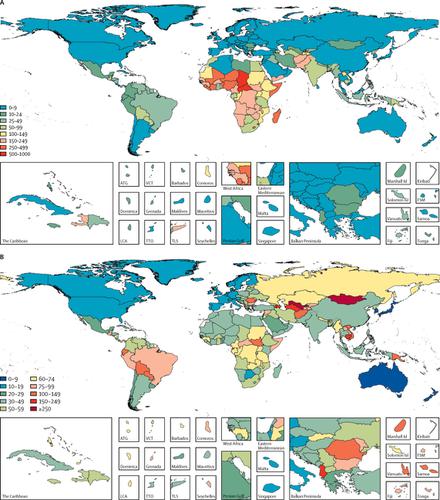Our official English website, www.x-mol.net, welcomes your feedback! (Note: you will need to create a separate account there.)
Global disability-adjusted life-year estimates of long-term health burden and undernutrition attributable to diarrhoeal diseases in children younger than 5 years.
The Lancet ( IF 168.9 ) Pub Date : 2018-03-01 , DOI: 10.1016/s2214-109x(18)30045-7 Christopher Troeger 1 , Danny V Colombara 1 , Puja C Rao 1 , Ibrahim A Khalil 1 , Alexandria Brown 1 , Thomas G Brewer 2 , Richard L Guerrant 3 , Eric R Houpt 4 , Karen L Kotloff 5 , Kavita Misra 6 , William A Petri 4 , James Platts-Mills 4 , Mark S Riddle 7 , Scott J Swartz 1 , Mohammad H Forouzanfar 1 , Robert C Reiner 1 , Simon I Hay 8 , Ali H Mokdad 1
The Lancet ( IF 168.9 ) Pub Date : 2018-03-01 , DOI: 10.1016/s2214-109x(18)30045-7 Christopher Troeger 1 , Danny V Colombara 1 , Puja C Rao 1 , Ibrahim A Khalil 1 , Alexandria Brown 1 , Thomas G Brewer 2 , Richard L Guerrant 3 , Eric R Houpt 4 , Karen L Kotloff 5 , Kavita Misra 6 , William A Petri 4 , James Platts-Mills 4 , Mark S Riddle 7 , Scott J Swartz 1 , Mohammad H Forouzanfar 1 , Robert C Reiner 1 , Simon I Hay 8 , Ali H Mokdad 1
Affiliation

|
BACKGROUND
Diarrhoea is a leading cause of death and illness globally among children younger than 5 years. Mortality and short-term morbidity cause substantial burden of disease but probably underestimate the true effect of diarrhoea on population health. This underestimation is because diarrhoeal diseases can negatively affect early childhood growth, probably through enteric dysfunction and impaired uptake of macronutrients and micronutrients. We attempt to quantify the long-term sequelae associated with childhood growth impairment due to diarrhoea.
METHODS
We used the Global Burden of Diseases, Injuries, and Risk Factors Study framework and leveraged existing estimates of diarrhoea incidence, childhood undernutrition, and infectious disease burden to estimate the effect of diarrhoeal diseases on physical growth, including weight and height, and subsequent disease among children younger than 5 years. The burden of diarrhoea was measured in disability-adjusted life-years (DALYs), a composite metric of mortality and morbidity. We hypothesised that diarrhoea is negatively associated with three common markers of growth: weight-for-age, weight-for-height, and height-for-age Z-scores. On the basis of these undernutrition exposures, we applied a counterfactual approach to quantify the relative risk of infectious disease (subsequent diarrhoea, lower respiratory infection, and measles) and protein energy malnutrition morbidity and mortality per day of diarrhoea and quantified the burden of diarrhoeal disease due to these outcomes caused by undernutrition.
FINDINGS
Diarrhoea episodes are significantly associated with childhood growth faltering. We found that each day of diarrhoea was associated with height-for-age Z-score (-0·0033 [95% CI -0·0024 to -0·0041]; p=4·43 × 10-14), weight-for-age Z-score (-0·0077 [-0·0058 to -0·0097]; p=3·19 × 10-15), and weight-for-height Z-score (-0·0096 [-0·0067 to -0·0125]; p=7·78 × 10-11). After addition of the DALYs due to the long-term sequelae as a consequence of undernutrition, the burden of diarrhoeal diseases increased by 39·0% (95% uncertainty interval [UI] 33·0-46·6) and was responsible for 55 778 000 DALYs (95% UI 49 125 400-62 396 200) among children younger than 5 years in 2016. Among the 15 652 300 DALYs (95% UI 12 951 300-18 806 100) associated with undernutrition due to diarrhoeal episodes, more than 84·7% are due to increased risk of infectious disease, whereas the remaining 15·3% of long-term DALYs are due to increased prevalence of protein energy malnutrition. The burden of diarrhoea has decreased substantially since 1990, but progress has been greater in long-term (78·7% reduction [95% UI 69·3-85·5]) than in acute (70·4% reduction [95% UI 61·7-76·5]) DALYs.
INTERPRETATION
Diarrhoea represents an even larger burden of disease than was estimated in the Global Burden of Disease Study. In order to adequately address the burden of its long-term sequelae, a renewed emphasis on controlling the risk of diarrhoea incidence may be required. This renewed effort can help further prevent the potential lifelong cost on child health, growth, and overall potential.
FUNDING
Bill & Melinda Gates Foundation.
中文翻译:

全球残疾调整后的生命年估算值,用于评估5岁以下儿童的腹泻病引起的长期健康负担和营养不良。
背景技术腹泻是全球5岁以下儿童死亡和疾病的主要原因。死亡率和短期发病率会给疾病带来沉重负担,但可能低估了腹泻对人群健康的真正影响。这种低估是因为腹泻疾病可能对肠道功能造成不利影响,并可能损害常量营养素和微量营养素的摄入,从而不利地影响了儿童早期生长。我们试图量化与腹泻引起的儿童生长障碍相关的长期后遗症。方法我们使用了全球疾病,伤害和危险因素研究框架,并利用了对腹泻发生率,儿童营养不良和传染病负担的现有估计,来估计腹泻疾病对身体生长的影响,包括体重和身高,以及5岁以下儿童的后续疾病。腹泻负担以残疾调整生命年(DALYs)衡量,这是死亡率和发病率的综合指标。我们假设腹泻与三种常见的生长指标呈负相关:年龄重,身高重和年龄高Z分数。在这些营养不良暴露的基础上,我们采用了反事实方法来量化传染病(随后的腹泻,下呼吸道感染和麻疹)的相对风险以及每天腹泻的蛋白质能量营养不良的发病率和死亡率,并量化腹泻疾病的负担由于这些结果是由营养不足引起的。结果腹泻发作与儿童成长步履蹒跚显着相关。我们发现,腹泻的每一天都与年龄高的Z分数(-0·0033 [95%CI -0·0024至-0·0041]; p = 4·43×10-14),体重有关年龄Z分数(-0·0077 [-0·0058至-0·0097]; p = 3·19×10-15)和身高体重Z分数(-0·0096 [ -0·0067至-0·0125]; p = 7·78×10-11)。营养不良导致长期后遗症加用DALY后,腹泻疾病的负担增加了39·0%(95%不确定区间[UI] 33·0-46·6),占55 2016年,年龄在5岁以下的儿童中有778 000 DALYs(95%UI 49 125 400-62 396 200)。在15 652 300 DALYs(95%UI 12 951 300-18 806 100)与因腹泻引起的营养不良有关,超过84·7%是由于感染疾病的风险增加,而剩余的15·3%的长期DALYs是由于蛋白质能量营养不良的患病率增加所致。自1990年以来,腹泻的负担已大大减少,但是长期的进展(减少78·7%[95%UI 69·3-85·5])比急性方面的进展更大(减少70·4%[95%])。 UI 61·7-76·5])DALY。解释腹泻比全球疾病负担研究所估计的疾病负担更大。为了充分解决其长期后遗症的负担,可能需要重新强调控制腹泻发生的风险。这项新的努力可以帮助进一步防止儿童健康,成长和整体潜力方面的潜在终生成本。资金比尔和梅琳达·盖茨基金会。但是长期的进展(减少78·7%[95%UI 69·3-85·5])比急性的进展大(减少70·4%[95%UI 61·7-76·5])亲爱的 解释腹泻比全球疾病负担研究所估计的疾病负担更大。为了充分解决其长期后遗症的负担,可能需要重新强调控制腹泻发生的风险。这项新的努力可以帮助进一步防止儿童健康,成长和整体潜力方面的潜在终生成本。资金比尔和梅琳达·盖茨基金会。但是长期的进展(减少78·7%[95%UI 69·3-85·5])比急性的进展大(减少70·4%[95%UI 61·7-76·5])亲爱的 解释腹泻比全球疾病负担研究所估计的疾病负担更大。为了充分解决其长期后遗症的负担,可能需要重新强调控制腹泻发生的风险。这项新的努力可以帮助进一步防止儿童健康,成长和整体潜力方面的潜在终生成本。资金比尔和梅琳达·盖茨基金会。为了充分解决其长期后遗症的负担,可能需要重新强调控制腹泻发生的风险。这项新的努力可以帮助进一步防止儿童健康,成长和整体潜力方面的潜在终生成本。资金比尔和梅琳达·盖茨基金会。为了充分解决其长期后遗症的负担,可能需要重新强调控制腹泻发生的风险。这项新的努力可以帮助进一步防止儿童健康,成长和整体潜力方面的潜在终生成本。资金比尔和梅琳达·盖茨基金会。
更新日期:2018-02-10
中文翻译:

全球残疾调整后的生命年估算值,用于评估5岁以下儿童的腹泻病引起的长期健康负担和营养不良。
背景技术腹泻是全球5岁以下儿童死亡和疾病的主要原因。死亡率和短期发病率会给疾病带来沉重负担,但可能低估了腹泻对人群健康的真正影响。这种低估是因为腹泻疾病可能对肠道功能造成不利影响,并可能损害常量营养素和微量营养素的摄入,从而不利地影响了儿童早期生长。我们试图量化与腹泻引起的儿童生长障碍相关的长期后遗症。方法我们使用了全球疾病,伤害和危险因素研究框架,并利用了对腹泻发生率,儿童营养不良和传染病负担的现有估计,来估计腹泻疾病对身体生长的影响,包括体重和身高,以及5岁以下儿童的后续疾病。腹泻负担以残疾调整生命年(DALYs)衡量,这是死亡率和发病率的综合指标。我们假设腹泻与三种常见的生长指标呈负相关:年龄重,身高重和年龄高Z分数。在这些营养不良暴露的基础上,我们采用了反事实方法来量化传染病(随后的腹泻,下呼吸道感染和麻疹)的相对风险以及每天腹泻的蛋白质能量营养不良的发病率和死亡率,并量化腹泻疾病的负担由于这些结果是由营养不足引起的。结果腹泻发作与儿童成长步履蹒跚显着相关。我们发现,腹泻的每一天都与年龄高的Z分数(-0·0033 [95%CI -0·0024至-0·0041]; p = 4·43×10-14),体重有关年龄Z分数(-0·0077 [-0·0058至-0·0097]; p = 3·19×10-15)和身高体重Z分数(-0·0096 [ -0·0067至-0·0125]; p = 7·78×10-11)。营养不良导致长期后遗症加用DALY后,腹泻疾病的负担增加了39·0%(95%不确定区间[UI] 33·0-46·6),占55 2016年,年龄在5岁以下的儿童中有778 000 DALYs(95%UI 49 125 400-62 396 200)。在15 652 300 DALYs(95%UI 12 951 300-18 806 100)与因腹泻引起的营养不良有关,超过84·7%是由于感染疾病的风险增加,而剩余的15·3%的长期DALYs是由于蛋白质能量营养不良的患病率增加所致。自1990年以来,腹泻的负担已大大减少,但是长期的进展(减少78·7%[95%UI 69·3-85·5])比急性方面的进展更大(减少70·4%[95%])。 UI 61·7-76·5])DALY。解释腹泻比全球疾病负担研究所估计的疾病负担更大。为了充分解决其长期后遗症的负担,可能需要重新强调控制腹泻发生的风险。这项新的努力可以帮助进一步防止儿童健康,成长和整体潜力方面的潜在终生成本。资金比尔和梅琳达·盖茨基金会。但是长期的进展(减少78·7%[95%UI 69·3-85·5])比急性的进展大(减少70·4%[95%UI 61·7-76·5])亲爱的 解释腹泻比全球疾病负担研究所估计的疾病负担更大。为了充分解决其长期后遗症的负担,可能需要重新强调控制腹泻发生的风险。这项新的努力可以帮助进一步防止儿童健康,成长和整体潜力方面的潜在终生成本。资金比尔和梅琳达·盖茨基金会。但是长期的进展(减少78·7%[95%UI 69·3-85·5])比急性的进展大(减少70·4%[95%UI 61·7-76·5])亲爱的 解释腹泻比全球疾病负担研究所估计的疾病负担更大。为了充分解决其长期后遗症的负担,可能需要重新强调控制腹泻发生的风险。这项新的努力可以帮助进一步防止儿童健康,成长和整体潜力方面的潜在终生成本。资金比尔和梅琳达·盖茨基金会。为了充分解决其长期后遗症的负担,可能需要重新强调控制腹泻发生的风险。这项新的努力可以帮助进一步防止儿童健康,成长和整体潜力方面的潜在终生成本。资金比尔和梅琳达·盖茨基金会。为了充分解决其长期后遗症的负担,可能需要重新强调控制腹泻发生的风险。这项新的努力可以帮助进一步防止儿童健康,成长和整体潜力方面的潜在终生成本。资金比尔和梅琳达·盖茨基金会。



























 京公网安备 11010802027423号
京公网安备 11010802027423号